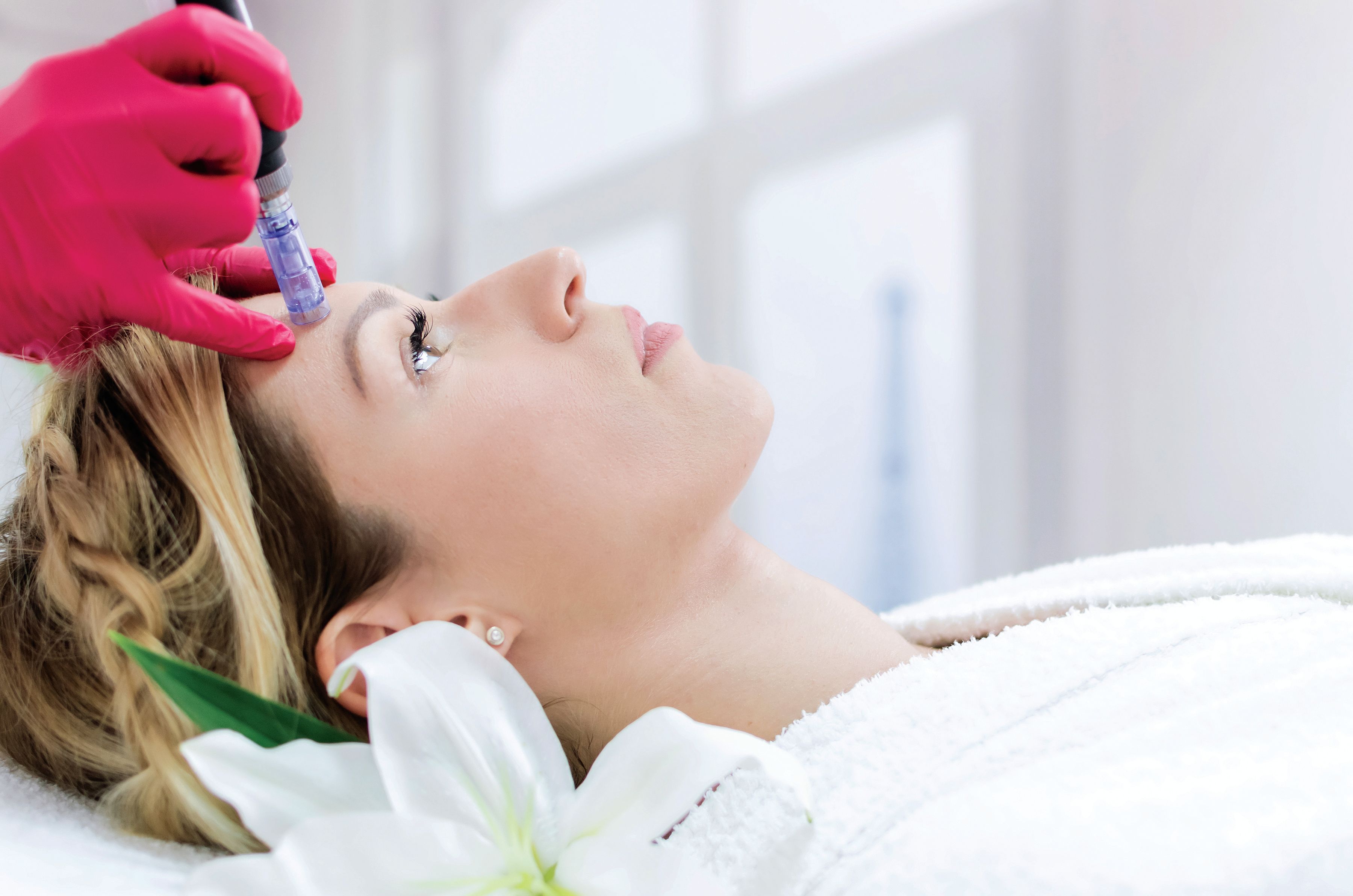- Acne
- Actinic Keratosis
- Aesthetics
- Alopecia
- Atopic Dermatitis
- Buy-and-Bill
- COVID-19
- Case-Based Roundtable
- Chronic Hand Eczema
- Chronic Spontaneous Urticaria
- Drug Watch
- Eczema
- General Dermatology
- Hidradenitis Suppurativa
- Melasma
- NP and PA
- Pediatric Dermatology
- Pigmentary Disorders
- Practice Management
- Precision Medicine and Biologics
- Prurigo Nodularis
- Psoriasis
- Psoriatic Arthritis
- Rare Disease
- Rosacea
- Skin Cancer
- Vitiligo
- Wound Care
Article
A candid Q&A about microneedling dos, don’ts
Author(s):
Suneel Chilukuri, M.D., weighs in on what physicians need to know about microneedling, including plusses and minuses of devices on the market, FDA clearance, ideal candidates, how to incorporate microneedling into treatment regimens and how to avoid complications and potential liability.
Suneel Chilukuri, M.D., answers questions on microneedling. (focusandblur - stock.adobe.com)

Dr. Chilukuri

Dermatologic surgeon Suneel Chilukuri, M.D., has used microneedling in practice for about nine years to treat a variety of skin problems - from acne scarring to pigmentary disorders. Dr. Chilukuri tells Dermatology Times that he learned microneedling dos and don’ts from Cape Town, South Africa, plastic and reconstructive surgeon Des Fernandes, M.B.; B.Ch. F.R.C.S.(Edin), who in 1997 pioneered the process of needling the skin in order to regenerate skin.
RELATED: Microneedling versus laser: Is one better than the other?
Dr. Chilukuri, of Refresh Dermatology in Houston, weighs in on what physicians need to know about this treatment option, including plusses and minuses of devices on the market, FDA clearance, ideal candidates, how to incorporate microneedling into treatment regimens and how to avoid complications and potential liability.
Q. What do physicians need to know about microneedling technology and differences in microneedling devices?
DR. CHILUKURI: Microneedling, more formally called collagen induction therapy, uses a mechanical rather than a heat based mechanism to improve the skin.
It’s something that every dermatologist, aesthetic physician and even primary care doctor and pediatrician should have. It’s inexpensive and can help patients, no matter what their skin color. The entry point is low. The physician might spend $5,000 or $6,000 for the device. Each of the tips is around $39 to $49.
Microneedling treatment improves skin texture. By creating an inflammatory response with mechanical trauma, fibroblast activity is increased, thus improving collagen production.
Pediatricians and family practitioners can use it for patients with acne scars. Surgeons can use it post Mohs to smooth scarring and get better healing. In our office, our top uses for microneedling are to treat acne scars, textural changes and pigmentary issues.
I use the Bellus Medical SkinPen, because it’s a big issue to make sure that we are using devices that are FDA cleared for safety. The SkinPen is the first microneedling system cleared by the FDA. It has 6,000 evolutions a minute. The needle doesn’t drag and what we’re finding is we don’t have to go to deep depths of 2.5 mm. Often times we’re treating at 1 mm or 1.5 mm to obtain pinpoint bleeding.
RELATED: Studies support microneedling efficacy for acne scarring
Now, if you’re trying to treat a deeper scar or acne scar - including boxcar, rolling and icepick scars - we might just use the microneedling device to “stamp” in that particular area.
The problem with a lot of roller devices is they’re not regulated, and the FDA has not allowed them in the U.S. for professional distribution. Patients can buy 0.25 mm microneedling rollers on Amazon for approximately $10 and replace them once a month. For many of the treatments that we do in-office, I encourage patients to buy the roller on Amazon for at-home use to enhance their in-office procedures. While these needling devices are not going to be nearly as effective as the medical-grade device we’re using, patients feel like they are active in their treatments and these may
help with the superficial texture of the skin.
Q. Do you prefer needles at fixed or adjustable depths?
DR. CHILUKURI: I prefer the ability to adjust needle depths based on the condition we are addressing for a patient. Dermatologists are skincare experts, and we really want to make sure we’re addressing the pathology of the condition we’re treating. If we’re treating somebody for rosacea, we might use a 0.5 mm needle to improve the skin barrier to decrease transepidermal water loss. If we’re treating a deeper scar, we’ll adjust the needle depth to penetrate anywhere from 1.5 mm to 2.5 mm.
The other thing is, we’re treating all over the face. On the cheek, even if you go 2.5 mm or 3 mm, the patient remains comfortable. But when you’re talking about the forehead, those depths are much more painful. When treating around the periocular region, you wouldn’t go to the same depth that you would on the cheek.
Q. Is pain an issue with microneedling?
DR. CHILUKURI: It is and there is a lot we can do to help prevent pain. There’s a relatively new product on the market called Prevadyne, which uses a lipophilic molecule to enhance delivery of a very low percentage of lidocaine. We’ve used it and it provides patients with comfort rapidly. In addition, 4% lidocaine can be used over large areas of the body (i.e., face, neck, chest) without high concern of lidocaine toxicity. As it is pre-packaged, I am less worried about contamination or the expense of compounded benzocaine, lidocaine, tetracaine (BLT).
RELATED: Microneedling improves acne scars, hyperpigmentation in skin of color
When I am treating a more sensitive area, I’ll perform a local block.
Q. What about contraindications, side effects and complications of microneedling treatment?
DR. CHILUKURI: It’s not so much that the microneedling will cause a complication, but rather what you’re having patients apply topically after - as well as when they apply topicals - that could affect outcomes.
Depending on which research paper you’re reading, those little channels inside the skin from microneedling close up from four minutes to four hours after treatment. Therefore, practitioners generally should recommend patients wait four or five hours before applying any topicals aimed at enhancing results.
Another consideration is a percentage of patients are allergic or sensitive to hydroquinone, so even though you might think you’re enhancing treatment by applying hydroquinone four hours after the microneedling, you can actually worsen the skin. Be cautious about using any topical that irritates the skin for somebody who is sensitive to pigmentation because it can worsen the pigmentation by increasing the inflammatory response.
It’s also important to understand the risk of infection. That’s another reason that I switched over to the SkinPen. Bellus Medical showed safety and decreased risk of infection in studies.
What I have seen occasionally is granulomas. The question becomes if somebody has permanent or semi-permanent fillers, are they going to be more sensitive to having a granuloma? I can’t say that it’s always due to a filler but that’s something to be cautious about. I ask patients beforehand if they have a history of having any kind of permanent filler, such as silicone or even semi-permanent polymethyl-methacrylate microsphere (PMMA) filler. I’m cautious about treating those patients with microneedling.
Finally, I ask if patients are on any blood thinners. It’s not a direct contraindication but you can notice prolonged bruising and the skin looks “beaten up” in some of these patients.
Q. Who does microneedling in your office?
DR. CHILUKURI: As long as I have seen the patients to make sure they’re good candidates, I delegate microneedling to my assistant. Microneedling can be done by aestheticians, RNs, nurse practitioners and/or physician assistants, depending on your local state laws. Like anything else, you have to make sure that these team members who are an extension of you in the practice are well trained.
Q. How do you incorporate microneedling in treatment regimens?
DR. CHILUKURI: We use it as an adjunct to many treatments. Physicians who don’t have skin lasers, for example, can treat patients with pigmentary issues with in-office chemical peels, microneedling, at-home microneedling and skincare products. For products, one can use topical antioxidants - our favorites are vitamins C and E and vitamin B3 - to help inhibit melanocyte activation. Patients can also use at-home microneedling to enhance retinol penetration.
Q. Any warnings or pearls that readers should note?
DR. CHILUKURI: Practitioners often publicize using platelet- rich plasma (PRP) immediately after microneedling, in a treatment trademarked the Vampire Facial. We have not seen any benefit from applying PRP topically post microneedling. Some claim that it is going to accelerate the healing process, but we have not seen that. I performed a split-face study with 24 subjects. On one side, we used PRP where you draw the blood, spin it down to get three to seven times the platelet concentration compared to normal blood and apply it topically. On the other side, we used a simple skincare product, Alastin Regenerating Skin Nectar. We found no difference in terms of erythema or long-term results. We measured at eight hours after microneedling, then again at 24 hours, one week and three months.
We need to be cautious about advising patients to apply topical treatments immediately after microneedling or using the device as a drug delivery system. We don’t always know how products are made and whether they are sterile. We have seen granuloma formation after applying vitamins C and E immediately after microneedling. While it will be innovative when we can use it as a true drug delivery system, we’re not quite there yet, in my opinion.
Readers should also note that there is a big difference between microneedling and radiofrequency (RF) microneedling. Depending on the area and what condition one is treating, practitioners may achieve more noticeable results by applying the RF microneedling. With acne scars, I typically start with an RF microneedling device. I then have my nurse perform regular microneedling as the second treatment. And, if needed, I’ll do a third treatment with RF microneedling because that will tighten the skin underneath, as well as give the superficial changes that we see from microneedling. Â
References:
Dr. Chilukuri has worked as a consultant and speaker for Alastin, Aerolase, Allergan, Bellus, BTL, Cynosure, Dominion Lasers, Eclipse, Galderma, InMode, Lutronic, Merz, PCA Skin, Sinclair, Sente, Skin Medica, Theravant, Under Skin and ZO Skin.
Newsletter
Like what you’re reading? Subscribe to Dermatology Times for weekly updates on therapies, innovations, and real-world practice tips.














